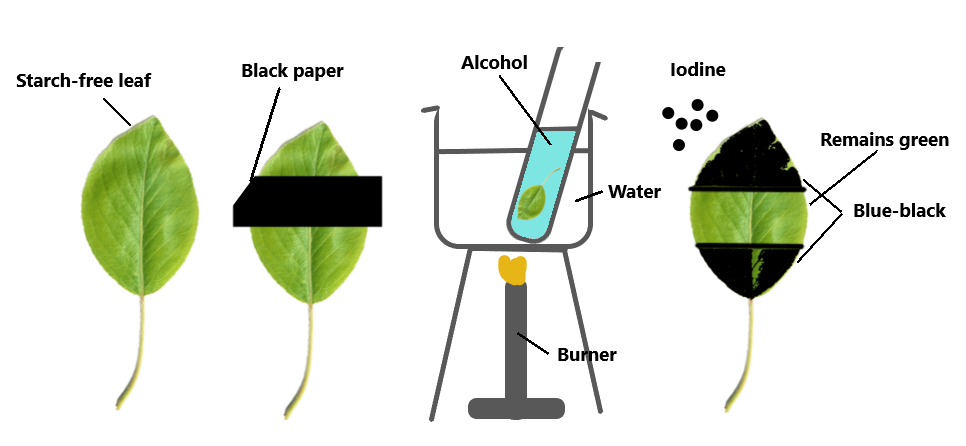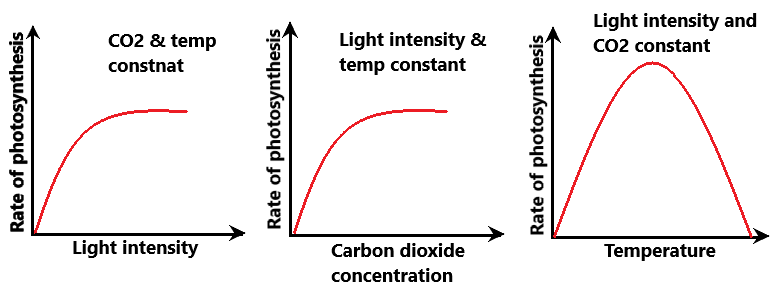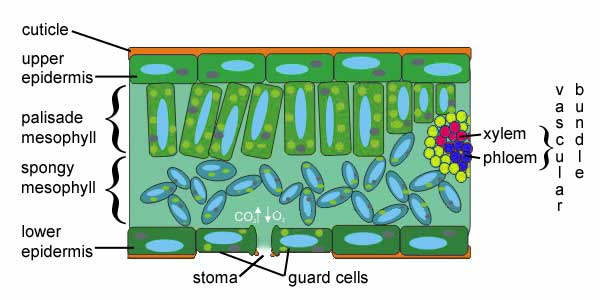Photosynthesis
Background
Photosynthesis is the process by which plants manufacture carbohydrates from raw materials using energy from light:

Chlorophyll is where photosynthesis happens. It transfers light energy into chemical energy for the synthesis of carbohydrates (i.e. glucose).
The glucose is then either converted to sucrose for transport around the plant or starch for storage.
Glucose is too reactive to be transported around the plant on its own. There it has to to be converted to sucrose first.
It is the same story with storage. Glucose cannot be stored due to its reactivity, so therefore it must be converted to starch first.
Limiting factor
The term limiting factor is something present in the environment in such a short supply that it restricts life processes.
For instance, if there was a shortage of carbon dioxide but all other raw materials were in abundance, then carbon dioxide would be the limiting factor for photosynthesis. If there was a shortage of chlorophyll, then that would become the limiting factor instead.
Investigations
Necessity of chlorophyll, light, and carbon dioxide
The equation for photosynthesis shows that chlorophyll, light, and carbon dioxide (and water) are required, otherwise it won’t work… But can we prove it? We sure can.
In a nutshell, what we need to do is get a functioning plant and deprive it of each of these factors individually and prove that the plant stops photosynthesizing when these factors are absent.
The way to do that is pretty simple. First of all we are going to de-starch all our plants by leaving the plants in the dark for 48 hours. During this period the plants will be unable to photosynthesize and therefore use up all its starch for respiration. This means that in the beginning of our experiments, all plants (test and control) will have absolutely no starch in them.
This means that after the experiment, if we do a starch test (iodine test) and we find starch is present, it would indicate that photosynthesis had occurred.
It is to note however that we can’t just add iodine onto a fresh leaf and expect results. First of all, we need to break the leaf so that iodine can seep in to begin with. Moreover, we need to remove the chlorophyll to decolourize the leaf so that the colour change from iodine is easier to see. So here are the steps we need to take:
- Boil the leaf in water
- Kills the leaf to make it permeable
- Boil the leaf in ethanol
- Chlorophyll dissolves and the leaf decolours
- Rinse the leaf in water
- Spread the leaf out on a white tile
- Add iodine solution
To investigate the effect of light on photosynthesis, we need to partially cover the leaves of the plant and leave it under sunlight. The covered areas will be deprived of light whereas the rest will be exposed. A starch test is then carried out after a few hours. The results should show that the covered areas have a negative starch test (i.e. no photosynthesis) whereas the exposed areas have a positive starch test.

To investigate the effect of carbon dioxide on photosynthesis, we place a test plant in a container with a carbon dioxide absorber (i.e. sodium hydroxide) and a control plant without the absorber. The absorber will remove the carbon dioxide.
A starch test is then carried out after several hours. The results should show that the test plant has a negative result whereas the control plant has a positive one.

To investigate the effect of chlorophyll on photosynthesis, we need to use a plant with variegated leaves. This means some parts of the leaf have chlorophyll whereas other parts do not (and are whiter thus).
After several hours, a starch test is carried out. The results should show that parts of the leaf without chlorophyll will show negative results whereas the parts that do have chlorophyll will show a positive result.

Effect of light intensity, carbon dioxide concentration, and temperature on rate of photosynthesis
You need to be aware of a couple of different graphs. They are quite simple so don’t worry.

- Graph 1: Rate of photosynthesis increases with light intensity until it plateaus. The graph plateaus because something else becomes the limiting factor (i.e. carbon dioxide). This means that even with a stronger light intensity, there may not be enough carbon dioxide to make the rate of photosynthesis even faster.
- Graph 2: Rate of photosynthesis increases with increasing carbon dioxide concentration. Again, at a certain point the graph will plateau. In this case, the light may become the limiting factor.
- Graph 3: The rate of photosynthesis increases with temperature until the graph reverses and eventually drops down to zero. This is because high temperatures will denature enzymes that are required for photosynthesis.
Leaf structure
You need to know the structure of a leaf, and how this structure is adapted for photosynthesis.

We will go through the functions of each of the structures in the diagram above:
- Cuticle – Made of wax which waterproofs the leaf
- Upper epidermis – A barrier against disease organism. The cells are thin and transparent to allow light to enter the leaf.
- Palisade mesophyll – Main site of photosynthesis. Cells are long and packed with chloroplasts to trap light energy. They receive carbon dioxide via diffusion from air spaces in the spongy mesophyll
- Spongy mesophyll – Cells are spherical and loosely packed. They contain chloroplasts but not as many as the palisade layer. Loose packing creates air spaces and this allows gas exchange (i.e. carbon dioxide to the cells, and oxygen from the cells)
- Vascular bundle – Contains xylem and phloem. Xylem vessels bring water and minerals to the leaf. Phloem vessels transport sugars and amino acids away from the leaf to the rest of the plant (translocation)
- Lower epidermis – Acts as a protective layer. It contains the stomata
- Stomata – These are gaps in the underside of the leaf, surrounding by a pair of guard cells. The guard cells control whether the stoma is open or closed. It is through stomata that carbon dioxide diffuses into the leaf and oxygen diffuses out. Water vapour is also lost through this structure in transpiration.
Mineral requirements
There are two important mineral requirements for plants that you need to be aware of.
Firstly, nitrate ions are important for plants as they are used in building amino acids (which eventually become proteins). A nitrate ion deficiency would slow down the growth of the plant, the stem would weaken. Lower leaves will turn yellow-ish and the upper leaves will become pale green as they die off.
Secondly, magnesium ions are required to make chlorophyll. If a plant has a magnesium ion deficiency then they will lack chlorophyll. Leaves turn yellow from the bottom of the stem upwards and plant growth will slow down due to reduced photosynthesis.
.